has announced a huge push into the exploding triathlon market with its new Speed Concept frame, which it calls “the fastest bike in the world.” Part of what makes the Speed Concept so fast, Trek CEO John Burke told a gathering of journalists and dealers last month in Los Angeles, is that it was designed specifically to be a triathlon bike.
I know that sounds odd, but the reality is that, while triathletes make up nearly the entire market for aero bikes, time trials in major road races like the Tour de France offer vastly better marketing exposure than even the most popular triathlon events. This means most aero bikes are designed according to the regulations of cycling’s governing body, the UCI, which are much more restrictive than those of triathlon federations. Triathletes, therefore, are generally left trying to trick out UCI-legal frames. Trek claims that with the Speed Concept, its road racers, like Lance Armstrong, will instead be racing dumbed-down triathlon bikes. (See images at end of post.)
“Today we introduce the most technologically advanced Trek ever, the all-new Speed Concept bike,” Burke told the audience in a lavish presentation at L.A.’s Frank Gehry-designed Disney Concert Hall. “It’s absolutely amazing, way beyond where anybody else is in the tri world.”
The Speed Concept is loaded with aero solutions like wheel-skewer levers that tuck behind the frame, fully hidden brakes, virtually no external cables, and a stowage compartment called the DraftBox that forms a faring behind the seatpost and seatstays to further enhance aerodynamic efficiencty. (No, that one’s definitely not UCI-legal.
Trek’s main design innovation, spotted on prototypes last summer at the Tour de France, was to square off the trailing edge of each tube on the frame. Where the cross sections of most aero tubes follow a traditional, teardrop airfoil shape, the tubes on the Speed Concept�� start out like an airfoil but end in a blunt, squared edge. (See images below.) This design, called a Kammtail, is already in wide use in the automotive industry, in high-end sports cars (think Lamborghini) and high-efficiency hybrids (think Prius).
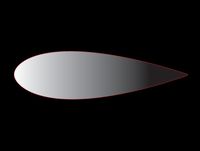
Trek claims that, especially at the lower speeds of cycling, the trailing edge of a traditional aero tube actually increases turbulence and drag. In wind-tunnel tests, Trek engineers found that the Kammtail tricks the air into following a “virtual airfoil” shape, but without the added drag at the tail. This was especially in cross winds. As an added benefit, the squared edge enhances lateral stiffness.
I’ve only had one hour on the Speed Concept so far, not enough for a full evaluation. But my ride took place in winds gusting over 25 miles per hour and on a route that involved sharp turns and winding roads. Even with deep-section aero rims, the bike felt much less vulnerable to sideways gusts. The lingering impression was one of remarkable stability. I could stay in the aero extensions through turns that would normally have me reaching for the base bars, and even in strong side winds, the bike stayed glued to the straight line I was trying to follow. It truly feels different from other aero bikes I’ve ridden (which, admittedly, isn’t a lot).
To underline Trek’s triathlon push, the company had three-time Ironman winner Chris Lieto and members of the Trek/K-Swiss triathlon team on hand for the presentation. Though the event was held in conjunction with the Tour of California, there were no Trek-sponsored road racers.Burke pointed out that Trek’s lowest market share is in the triathlon category. That segment has seen 30 percent growth over the past five years, and Burke said there are now 1.2 million triathletes in the U.S. alone. It’s a segment he said Trek could simply no longer afford to ignore.
“We had limited resources and we spent a lot of time and effort on road bikes and not that same time and effort on tri bikes,” Burke said. “But in the last four years we’ve added a lot of resources, and that’s how this came about.”
Burke said that resource push also allowed Trek to introduce a full, top-to-bottom line around the Speed Concept. Instead of coming to market with a top-tier model and introducing lower price points in later years, Trek has brought out a full line. At the top of the line stands the 9 Series bikes, which are full carbon and include a unique, integrated, and fully adjustable aero stem/bar solution. Prices will range from $5,500 to $8,500
Next down the line comes the 7 Series. Though also full carbon, these bikes replace the front end of the 9 Series with a more traditional fork, steerer, stem, and head tube. Trek claims that in its wind tunnel testing, the 7 Series outperformed every aero bike on the market except for the 9 Series. Prices will run from $2,400 to $3,500.
For the budget-conscious, there will also be an aluminum-framed 2 Series, which will carry over many of the Kammtail shapes, but at a sub $2,000 price. The 9 series is in stores now, while the 7 and 2 Series will be available later this summer.
—John Bradley
Twitter: johnwbradley
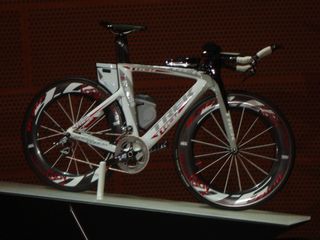
Set up for triathlon (apologies for image quality)…
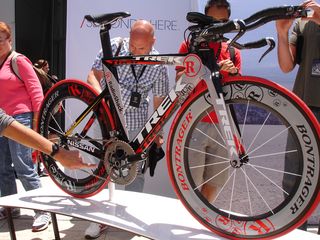
…and set up UCI-legal.
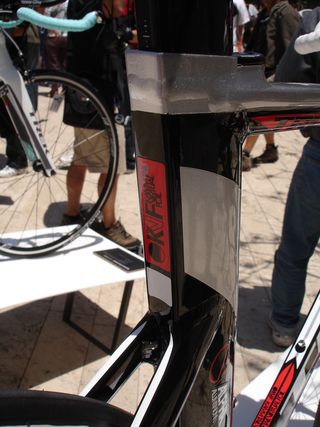
An example of the Kammtail shape, here on the back of the seat tube.
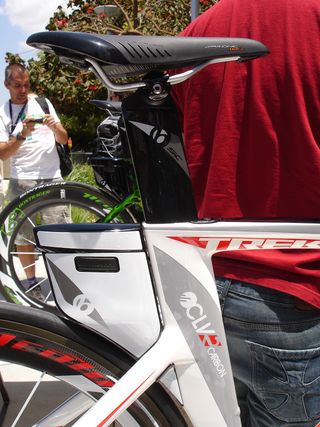
The DraftBox stores tools and food and, depending on the wind angle, is aerodynamically either neutral or beneficial, according to Trek.
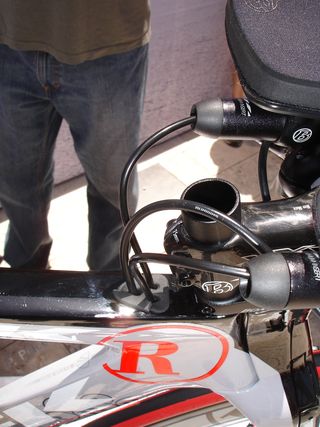
The UCI-legal set-up has a traditional stem and steerer tube, rounded shapes on the aero bars, and exposed cables.
��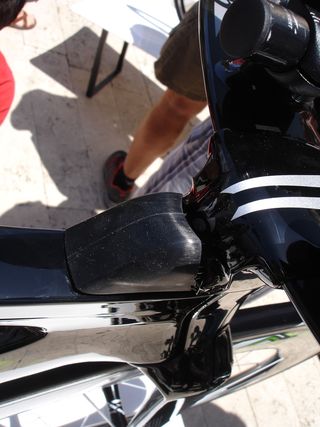
Here's the much neater, faster tri-specific stem and bar combination: Hidden steerer and flat, wind-cheating bars. That black bulge behind the stem is a rubber housing that shrouds the few exposed cables from the wind.
��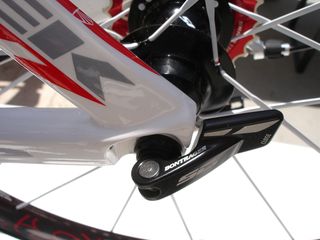
Even the levers on the skewers are tucked away out of the wind.